What bird is currently perching on your head? A Parakeet? Parrot? Peacock? Pigeon? Well, probably not, but I hope you know the correct answer when you are asked. Today’s article is about birds that start with the letter P. And in this list of 29 birds that begin with the letter P, you are guaranteed to learn something new.
Pied Avocet (Recurvirostra avosetta)
Pied Avocets are a large migratory species of the Recurvirostridae bird family. Their breeding regions stretch across the Palearctic to Central Asia to the Russian Far East.
Most of the birds in this species spend their winters in Africa or Southern Asia. Pied Avocets generally inhabit shallow brackish water and lakes.
Due to the lack of any sexual dimorphism, both sexes of this species have the same white plumage, with black patches on the back and wings. They also have long bluish legs and a long bill.
Their diet is mainly composed of insects and crustaceans.
Pine Grosbeak (Pinicola enucleator)

Pine Grosbeaks are a partially migratory bird species. These birds also happen to be the only species in the Pinicola genus. They are dispersed across the western mountains of the United States, Canada, and the subarctic zone.
Pine Grosbeaks breed across the coniferous forests of North America and northern Eurasia. While a major part of their population stays at their breeding grounds all year round, some of them fly shorter distances to the south.
They have blackish forked tails, black wings, whitish wing bars, and large bills. The heads of the males are rose-red, while in females, it is olive-yellow.
Pine Grosbeaks have overall black plumage, with white wing bars and a black, forked tail. Their heads, backs, and rumps are covered in red, and they have conical beaks.
On the other hand, the adult females are olive-yellow on the head and rump, with a grey shade on their back and underpart.
Pyrrhuloxia (Cardinalis sinuatus)
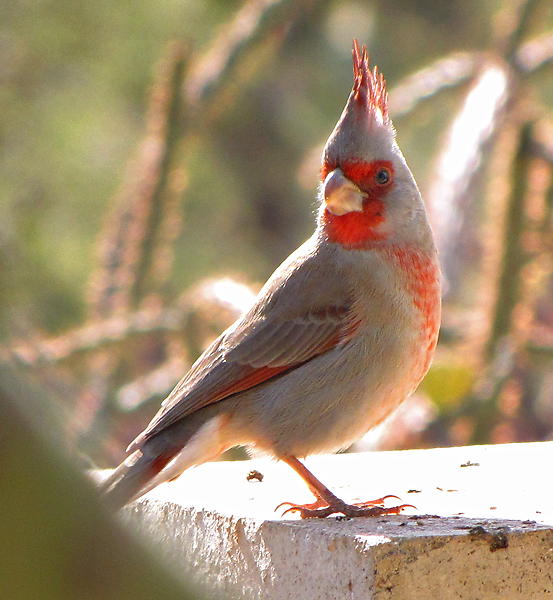
Pyrrhuloxias are North American passerine songbirds commonly found across southwest America and northern Mexico. Usually inhabiting desert scrubs, mesquite thickets, and woodland areas, these birds are also commonly referred to as the “Desert Cardinals.”
Pyrrhuloxias have a brownish-grey body with red breasts and a mask. Their parrot-like, rounded bills are stout and yellow. These birds display sexual dimorphism in their plumage, with males having more red in their plumes than their female counterparts.
Fruits, seeds, and insects make up the primary diet of the Desert Cardinals.
Pied Crow (Corvus albus)
Pied Crows are a corvid species widely spread across Africa. These birds inhabit open villages and nearby towns and are rarely spotted far from the human population.
The heads and necks of Pied Crows are a vibrant black, with white feathers stretching from their shoulders to lower breasts. Their bills, wings, and tails are black, too, while the eyes are a rich, dark brown.
Pied Crows mainly feed on small invertebrates, tiny reptiles, eggs, peanuts, young birds, and more.
Purple Martin (Progne subis)
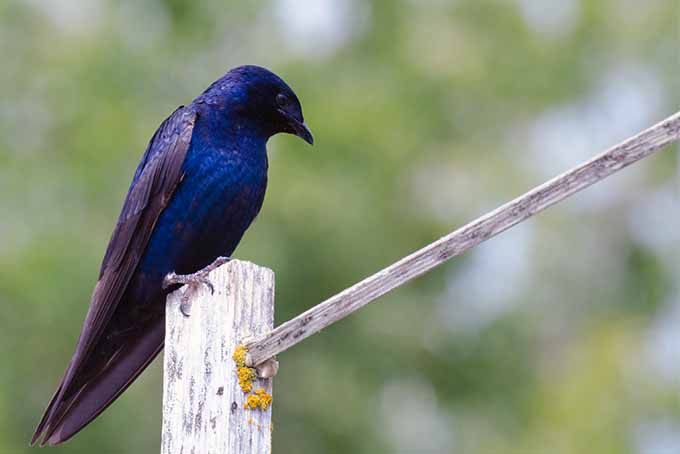
Purple Martins are a migratory bird species in North America that spend the winter in South America. They breed across central Alberta down through the eastern United States.
Contrary to what their name might indicate, the plumage of these birds is not actually purple. Rather, blackish-blue feathers appear to be deep blue in appearance due to the refraction of incident light.
Displaying sexual dimorphism, the adult males are completely black with a bluish sheen in their bodies. Their female counterparts have dark upper parts with a slight bluish touch, and the underparts are lighter. Both sexes have slightly forked tails.
Purple Martins’ diet includes flies, moths, beetles, winged ants, wasps, and other flying insects.
Pheasant Cuckoo (Dromococcyx phasianellus)

The Pheasant Cuckoos are a neotropical bird species endemic to Central and South America. They usually inhabit lowland tropical forests, riverine forests, and tropical deciduous forests.
Pheasant Cuckoos are large birds with dark brown upperparts and pale buff underparts, with small black stripes on their breast. Their crests are tossed with rusty-brown. They also have a large tail, with the central tail feathers being the longest.
Pheasant Cuckoos are insectivorous birds, which thrive on beetles, grasshoppers, cicadas, lizards, and the occasional nestlings.
Pacific Loon (Gavia pacifica)
Pacific Loons are medium-sized, migratory seabirds that breed on tundra lakes in northern Canada and Eastern Siberia. These birds spend their winters across the North American Pacific coast. Many birds of this species are also spotted in Europe and Iceland during the winters.
Unlike other species of the Loon family, these birds prefer migrating in flocks. Non-breeding adults feature a grey head, black throat, white underparts, and black-white streaked mantle. They also have dagger-shaped bills that are either grey or white.
Interestingly enough, the feet of the Pacific Loons are placed far back on their bodies, which makes them great swimmers. However, this is also why they can barely walk on land and cannot take flight from the ground.
Piping Plover (Charadrius melodus)
Piping Plovers are tiny, sand-colored shorebirds of North America that inhabit sandy beaches and rocky shores. These birds are migratory in nature; while they spend their summers in the northern United States and Canada, they migrate to the Gulf of Mexico in the winters.
As we have already mentioned, these birds have sand-colored plumage, with white underparts.
They also have a steadily built body with a rounded head, short thick neck, and squatty bills that are orange colored with a black tip at the edge. Their legs are a combination of yellow and orange, and a black band is prominent on the forehead from one eye to the other.
Pygmy Falcon (Polihierax semitorquatus)
Pygmy Falcons are a tiny raptor species endemic to eastern and southern Africa that also happen to be the smallest raptors on the entire continent. These birds flourish in arid and semi-arid zones with minimal ground covers and scattered large trees.
The adult Pygmy Falcons are whitewashed on their face and breast and have a grey head. They have spotted black and white flight feathers and tails.
Pacific Screech-Owl (Megascops cooperi)
Pacific Screech Owls are medium-sized nocturnal birds native to Central America. Mangroves, swamps, semi-arid and arid forests form the natural habitats for these birds of prey.
Pacific Screech Owls have prominent ear tufts and a pale grey facial disk lined with white and blackish borders. Their upperparts are tawny grey, while the lower parts are off-white. Like most owls, they, too, have bright yellow eyes.
Pigeon Guillemot (Cepphus columba)
Pigeon Guillemots are a medium-sized, migratory seabird species endemic to the North Pacific Coastal Waters. The breeding habitats of these birds include rocky shores and islands that are close to shallow waters and lakes.
These birds have a dark brown breeding plumage with white wing patches. During the winters, their upper parts gain a shimmery black complexion, while their underparts are white.
Their crowns, foreheads, eye lines, and ear coverts are all black with white tips. Their underwings are pale and dark irrespective of their plumage.
There is no record of any sexual dimorphism between the adult sexes, in either plumage or size.
Purple Gallinule (Porphyrio martinicus)

Purple Gallinules are medium-sized rails native to the southeastern United States. In their non-breeding season, however, they are more often spotted across the inland areas of Central America.
Purple Gallinules have long legs and toes that help to walk smoothly into floating vegetation.
Their plumage is purplish-blue but appears to be shiny green in good lighting.
These birds have a pastel blue shield on their foreheads with reddish-yellow bills. Their legs and feet are bright yellow.
Pelagic Cormorant (Urile pelagicus)
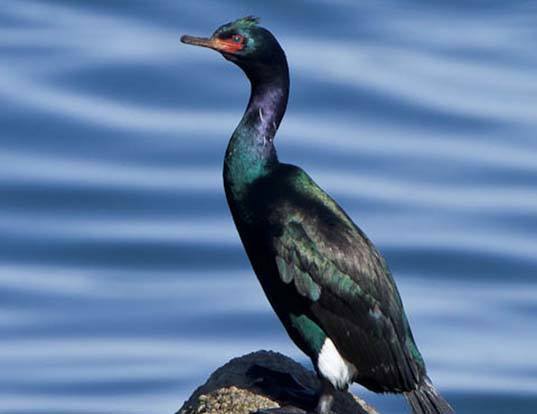
Pelagic Cormorants are a non-migratory waterbird species native to northwest America. These birds prefer to nest and breed on cliffs and the headlands of rocky coasts.
Their breeding plumage is characterized by two short crests, white thighs, and white flop fumes on the head and neck. The dark skin just below the eye also appears to be a polished shade of magenta during this time.
In their non-breeding plumage, these cormorants are fully black with metallic glitter. Their long, thin bills are black throughout the year.
Parakeet Auklet (Aethia psittacula)

Parakeet Auklets are a tiny seabird species endemic to the North Pacific. They are commonly found in the boreal waters of Alaska, Kamchatka, and Siberia. Cliffs, boulder fields of offshore islands are their primary breeding habitats.
The plumage on the upper parts of Parakeets Auklets is dark, while the underparts are white. A single white plume projects from their eye, which is a distinguishing feature of these birds. They have short, orange bills.
Painted Stork (Mycteria leucocephala)
The Painted Storks are large wader birds found in the Indian Subcontinent. These storks are also commonly spotted on the plains of tropical Asia, south of the Himalayas.
Painted Storks get their name from their pink tertial feathers that are found in adults. Unfortunately, their beautiful plumage is the reason why these birds have a near threatened population status.
Painted Storks have a heavy, yellow-colored beak with a down-curved tip, similar to that of an Ibis. They have a bare head, which is usually orange or reddish in color. Their long tertial feathers have pink tips and extend over their back and rump when at rest.
Pinnated Bittern (Botaurus pinnatus)
The Pinnated Bitterns are large bitterns endemic to Paraguay that are commonly found in the New World tropics. They are nocturnal birds that inhabit areas around freshwater and waterlogged depressions.
Both sexes of this species display strong sexual dimorphism in size, with the males being larger and heavier than the females.
All adults have similar plumage, with their upper parts colored in a muddy brown hue, while underparts are white with a few brownish markings.
Peruvian Pelican (Pelecanus thagus)
Peruvian Pelicans are a near-threatened bird species of the Pelican family. These birds are found on the west coast of South America and Northern Peru. Additionally, they occur in southern Chile and Ecuador as visitors.
Peruvian Pelicans have dark plumage, with a single white stripe running from the top of their bill, to their crown and down the sides of their neck. They also have a few long, tufted feathers on the top of their head.
Peaceful Dove (Geopelia placida)
Peaceful Doves are a non-migratory pigeon species that are endemic to Australia and New Guinea.
Like all other pigeon and dove species, these birds, too, lack sexual dimorphism between their counterparts. Both sexes have a pink-and-grey breast, with checkered brown wings. One of their identifying factors is the blue-grey rings that surround their eyes.
Pink-Footed Goose (Anser brachyrhynchus)
Pink-footed Geese are a migratory waterbird species, breeding in eastern Greenland, Iceland, and Svalbard. They spend their winters in northwest Europe.
Pink-footed Geese are medium-sized birds with short bills colored pinkish shade in the middle and tipped with black. Their body is mainly greyish brown with a dark brown head and neck. Their white tail has a prominent white tip, with characteristic pink legs and feet.
Palm-Nut Vulture (Gypohierax angolensis)
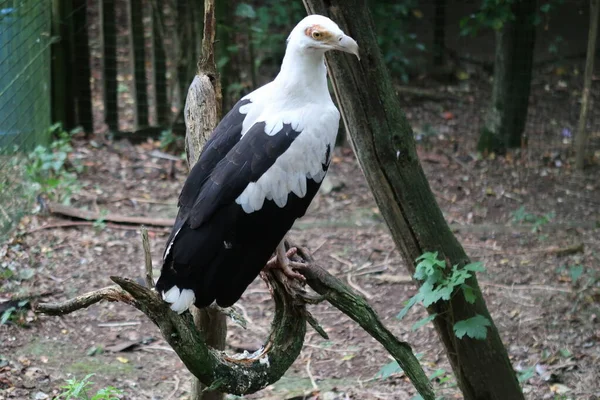
Palm-Nut Vultures are large raptors in the Accipitridae bird family. They are common throughout the coastal regions of the African continent, primarily inhabiting coastal forests and mangrove swamps in wet savannas.
Except for black wings and tails, these scavengers have completely white plumage. They also have red patches around the eyes. Both the sexes have a similar size and appearance.
Pink Pigeon (Nesoenas mayeri)
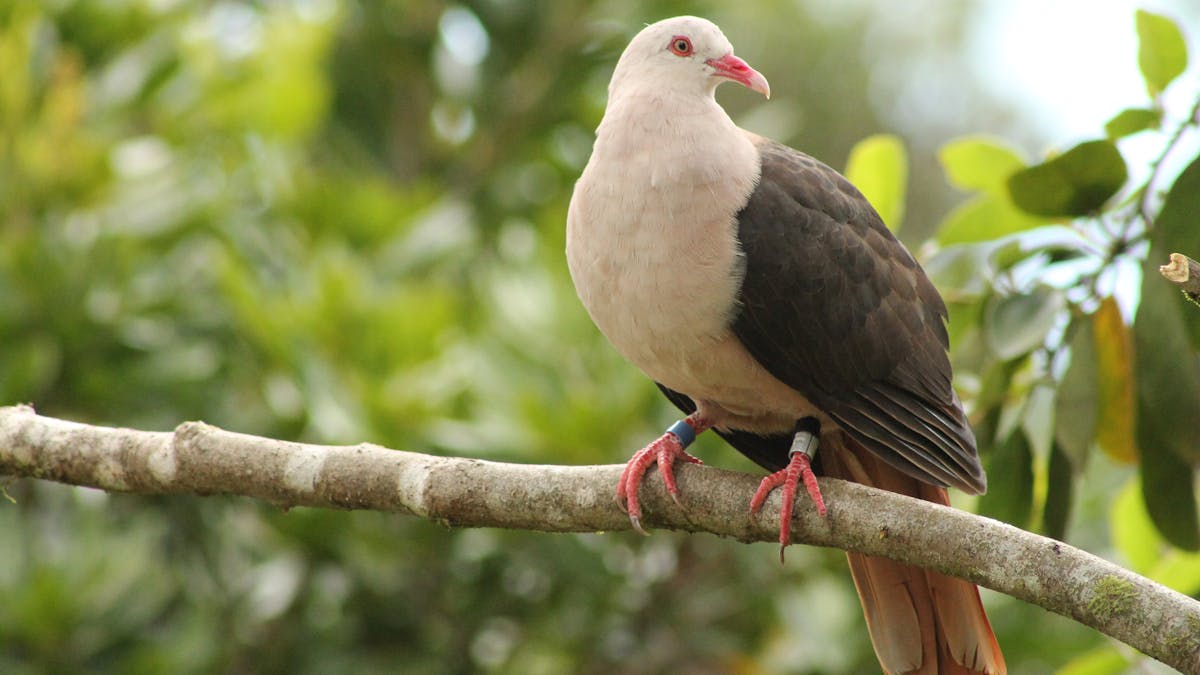
Endemic to Mauritius, Pink Pigeons are a very rare pigeon species that almost went extinct in the 1990s and are still very rare.
In fact, there are only two places in the world where they can be found: the Mascarene Island of Mauritius, and the Isle aux Aigrettes, which is a predator-free island.
Pink Pigeons are known for their unique pink and greyish plumage. They even have pink feet and a white-tipped, pink beak.
Pied Plover (Vanellus cayanus)

Also known as “Pied Lapwing,” the Pied Plovers are a plover species commonly found in places like Argentina, Bolivia, and Peru. They inhabit forest rivers, sea coasts, and woodlands.
Pied Plovers have bold black and white feathers, along with a distinct black V shape on their backs. Their orange legs and small beaks are a few of their most characteristic physical features.
Peruvian Booby (Sula variegata)

The Peruvian Boobies are a waterbird species that are endemic to South America and are found off the shores of Peru.
Peruvian Boobies have brown upper parts with white underparts and a white-colored head. There are also splashes of white on the upper side of their wings, and their wing coverts are white-tipped, which creates a scale-like pattern.
These birds also have webbed feet, a common characteristic in all waterbirds. The adults are sexually dimorphic in size, not in color, with the females being larger than the males. The females have a honk-like sound, while males generally whistle.
Pileated Woodpecker (Dryocopus pileatus)

Pileated Woodpeckers are an insectivorous woodpecker species endemic to North America. These birds are overall black with red crests and white lines down the sides of the throats.
The adult male Pileated Woodpeckers have a distinguishing red line from their bill to their throat, which is black in females.
They inhabit mature forests and heavily wooded parks or gardens. Pileated Woodpeckers mainly feed on insects. They also prefer eating nuts, berries, and fruits.
Purple Sandpiper (Calidris maritima)

Purple Sandpipers are small migratory shorebirds that breed in Arctic islands in Canada, coastal areas in Greenland, and northwestern Europe. These are late migrants, wintering in the rocky, ice-free Atlantic.
Purple Sandpiper are medium-sized birds with greyish breasts and dark bills with a yellowish base. Their upper parts are dark with a slight purplish shine, underparts are white, with yellow legs.
Puerto Rican Woodpecker (Melanerpes portoricensis)
As their name suggests, the Puerto Rican woodpeckers are endemic to the island of Puerto Rico. They occur mainly in coffee plantations, parks, and mangroves.
These woodpeckers have a black body and bright red throat. They’re highly sexually dysmorphic, with the males being more brightly colored and having a larger bill than their female counterparts.
Pale-Vented Pigeon (Patagioenas cayennensis)
Pale-Vented Pigeons are large-bodied pigeons that breed in southern Mexico. These birds stray to countries like Uruguay from time to time.
Pale-vented Pigeons display sexual dimorphism in their plumage. The males are purple-colored overall, black-billed, red-eyed and have grey underparts. Their female counterparts are colored similarly but less brightly.
Purple Heron (Ardea purpurea)

The Purple Herons are evasive birds that live mostly in dense vegetations. They are migratory and breed in Africa, Europe, and parts of Asia, and traveling south to tropical parts of Asia during winters. They are hunting birds known for their long brownish-yellow beaks.
Though large, these are slender birds that have S-shaped necks. Their head crown is black in color, and their upper parts are brownish-grey. Purple Herons act as an indicator of rising pollution in water bodies.
Pine Siskin (Spinus pinus)
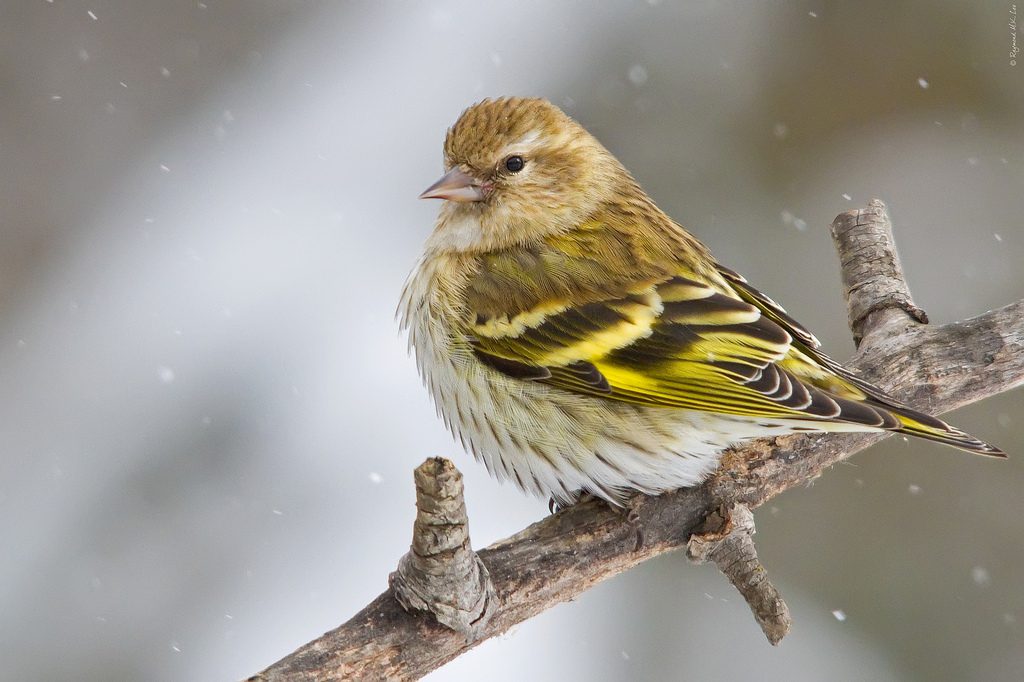
Pine Siskins are a North American migratory bird species breeding in open coniferous forests across Alaska and Canada. These birds are also commonly addressed as “Irruptive Winter Finches” due to the high variation in their movements based on food supply.
Pine Siskins have brownish upper parts and lighter underparts. Their wings and tails have yellow patches, with an occasional white streak on their wings. Their conical bills are elongated and slender.
Conclusion: Birds That Start With P
Hopefully, you enjoyed our article on the birds beginning with P. This is a list I’ve been fascinated with for a long time and I wanted to share it with y’all. People seem to be into this type of list on the internet these days, so I know that there are people who would read about it as well.
If you like my list, please pass it along to others on your favorite social media networks.
Birds By Alphabet (A-Z List)
Birds that Start with A
Birds that Start with B
Birds that Start with C
Birds that Start with D
Birds that Start with E
Birds that Start with F
Birds that Start with G
Birds that Start with H
Birds that Start with I
Birds that Start with J
Birds that Start with K
Birds that Start with L
Birds that Start with M
Birds that Start with N
Birds that Start with O
Birds that Start with P
Birds that Start with Q
Birds that Start with R
Birds that Start with S
Birds that Start with T
Birds that Start with U
Birds that Start with V
Birds that Start with W
Birds that Start with X
Birds that Start with Y
Birds that Start with Z













